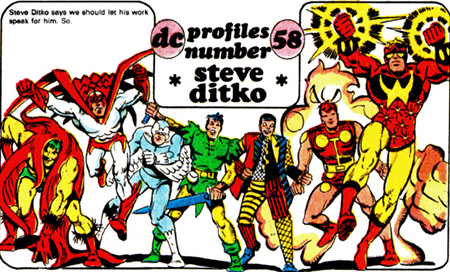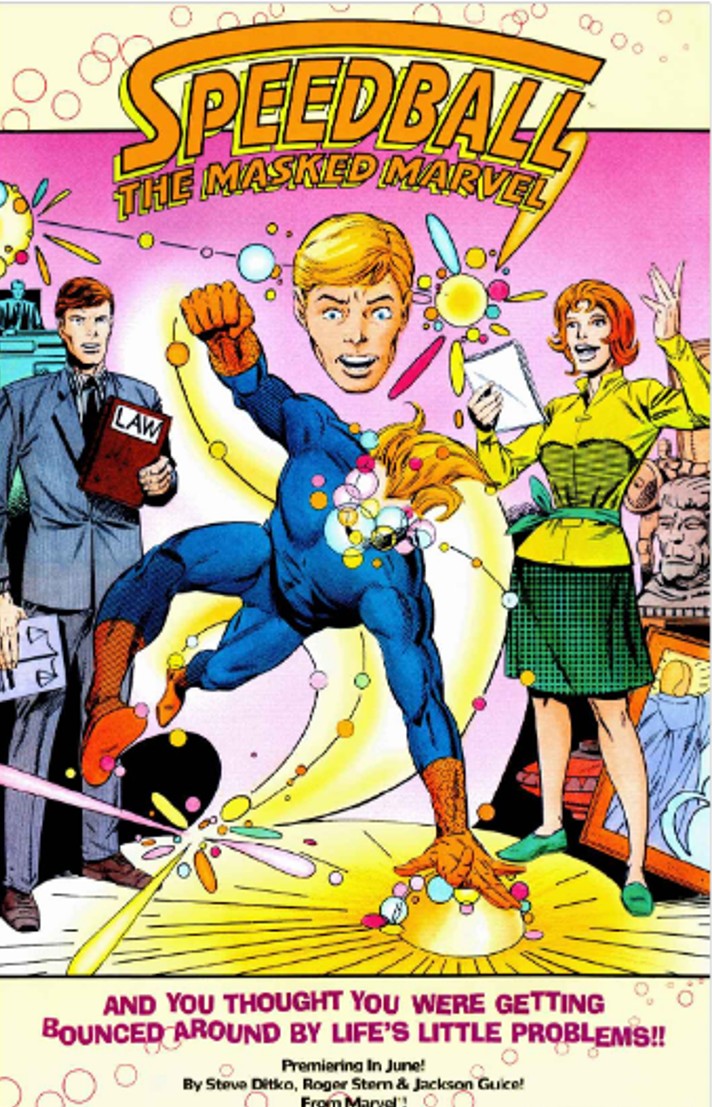Blasphemy!I knew that once he was on ROM that the series was over(which might have been a good thing).
Steve Ditko
Moderators: sgt.null, dANdeLION, aTOMiC
- Fist and Faith
- Magister Vitae
- Posts: 25472
- Joined: Sun Dec 01, 2002 8:14 pm
- Has thanked: 9 times
- Been thanked: 57 times
That X-Men run Smith did was awesome. I hated that #175 was only partially Paul's art; the other artist paled in comparison.
Rom...heh, Rom sucked consistently enough that I hardly ever read an issue. Sal Buscema never did it for me.....though I'll give him props for not ruining Barry Smith's pencils on Conan.
Sal Buscema never did it for me.....though I'll give him props for not ruining Barry Smith's pencils on Conan.
Rom...heh, Rom sucked consistently enough that I hardly ever read an issue.
When the man with a 45 meets the man with a rifle, you said the man with a pistol is a dead man. Let's see if it's true.
- High Lord Tolkien
- Excommunicated Member of THOOLAH
- Posts: 7393
- Joined: Tue Oct 19, 2004 2:40 am
- Location: Cape Cod, Mass
- Been thanked: 3 times
- Contact:
I loved ROM right up until the females took over and then they went from science to magic.
Then it kinda sucked.
Firefall, Hybrid, Saga of the Spaceknights.....
All the early stuff was pretty cool.
Then it kinda sucked.
Firefall, Hybrid, Saga of the Spaceknights.....
All the early stuff was pretty cool.
https://thoolah.blogspot.com/
[Defeated by a gizmo from Batman's utility belt]
Joker: I swear by all that's funny never to be taken in by that unconstitutional device again!




[Defeated by a gizmo from Batman's utility belt]
Joker: I swear by all that's funny never to be taken in by that unconstitutional device again!




- dANdeLION
- Lord
- Posts: 23836
- Joined: Thu Sep 11, 2003 3:22 am
- Location: In the jungle, the mighty jungle
- Contact:
Rom is an abomination. Look it up in Revelations. 

Dandelion don't tell no lies
Dandelion will make you wise
Tell me if she laughs or cries
Blow away dandelion
I'm afraid there's no denying
I'm just a dandelion
a fate I don't deserve.
High priest of THOOOTP
 *
*
* This post carries Jay's seal of approval
Dandelion will make you wise
Tell me if she laughs or cries
Blow away dandelion
I'm afraid there's no denying
I'm just a dandelion
a fate I don't deserve.
High priest of THOOOTP
* This post carries Jay's seal of approval
- aTOMiC
- Lord
- Posts: 24970
- Joined: Wed Sep 10, 2003 6:48 am
- Location: Tampa, Florida
- Has thanked: 19 times
- Been thanked: 13 times
- Contact:
Ditko was and is a difficult prospect in my mind. His art along with Jack Kirby and Don Heck represent a defining moment in the early days of Marvel Comics that launched a revolution in the comic industry that continues today. Groundbreaking isn't a word strong enough to express the impact Ditko's contribution to books that include......
Aw who am I kidding? When I was a kid I thought his art sucked. I appreciate it far more now than I did but his work still looks kinda goofy to these eyes. I grew to value Kirby over time. Only Don Heck remains unappreciated in any way, shape or form. Yuck!
Aw who am I kidding? When I was a kid I thought his art sucked. I appreciate it far more now than I did but his work still looks kinda goofy to these eyes. I grew to value Kirby over time. Only Don Heck remains unappreciated in any way, shape or form. Yuck!
"If you can't tell the difference, what difference does it make?"
"There is tic and toc in atomic" - Neil Peart
- dANdeLION
- Lord
- Posts: 23836
- Joined: Thu Sep 11, 2003 3:22 am
- Location: In the jungle, the mighty jungle
- Contact:
Heh, this needs to be moved to the Comics forum.
Dandelion don't tell no lies
Dandelion will make you wise
Tell me if she laughs or cries
Blow away dandelion
I'm afraid there's no denying
I'm just a dandelion
a fate I don't deserve.
High priest of THOOOTP
 *
*
* This post carries Jay's seal of approval
Dandelion will make you wise
Tell me if she laughs or cries
Blow away dandelion
I'm afraid there's no denying
I'm just a dandelion
a fate I don't deserve.
High priest of THOOOTP
* This post carries Jay's seal of approval
- CovenantJr
- Lord
- Posts: 12608
- Joined: Fri Mar 22, 2002 9:10 pm
- Location: North Wales
- dANdeLION
- Lord
- Posts: 23836
- Joined: Thu Sep 11, 2003 3:22 am
- Location: In the jungle, the mighty jungle
- Contact:
Dandelion don't tell no lies
Dandelion will make you wise
Tell me if she laughs or cries
Blow away dandelion
I'm afraid there's no denying
I'm just a dandelion
a fate I don't deserve.
High priest of THOOOTP
 *
*
* This post carries Jay's seal of approval
Dandelion will make you wise
Tell me if she laughs or cries
Blow away dandelion
I'm afraid there's no denying
I'm just a dandelion
a fate I don't deserve.
High priest of THOOOTP
* This post carries Jay's seal of approval
- kevinswatch
- "High" Lord
- Posts: 5592
- Joined: Sat Mar 02, 2002 2:46 pm
- Location: In the dark, lonely cave that dwells within my eternal soul of despair. It's next to a Pizza Hut.
- Has thanked: 6 times
- Been thanked: 5 times
- Contact:
- Fist and Faith
- Magister Vitae
- Posts: 25472
- Joined: Sun Dec 01, 2002 8:14 pm
- Has thanked: 9 times
- Been thanked: 57 times
- CovenantJr
- Lord
- Posts: 12608
- Joined: Fri Mar 22, 2002 9:10 pm
- Location: North Wales
- sgt.null
- Jack of Odd Trades, Master of Fun
- Posts: 48362
- Joined: Tue Jul 19, 2005 7:53 am
- Location: Brazoria, Texas
- Has thanked: 8 times
- Been thanked: 10 times

DR. STRANGE Ditko revolutionized the way comics depicted magic when he uncorked the Master Of Mystic Arts on an unsuspecting populace back in STRANGE TALES #110 (Jul '63). Stan Lee's bizarre incantations grooved perfectly with Ditko's ability to manifest strange dimensions like no other creator since. His work on Spider-Man may be his most famous, but plenty of people would regard his run (up to #146) on this character as his finest. The page shown here is the fifth and final page from the first appearance of the Good Doctor.
en.wikipedia.org/wiki/Dr._Strange
After debuting in Strange Tales #110 and returning in the next issue, the 9- to 10-page feature "Dr. Strange" skipped two issues and then returned permanently with #114 (Nov. 1963). Steve Ditko's surrealistic mystical landscapes and increasingly head-trippy visuals helped make the feature a favorite of 1960s college students, according to contemporaneous accounts. Ditko, as co-plotter and later sole plotter, in the "Marvel Method", would eventually take Strange into ever-more-abstract realms that nonetheless remained well-grounded thanks to Stan Lee's reliably humanistic, adventure/soap opera dialog. Doctor Strange shared the "split book" Strange Tales with solo adventures of Fantastic Four member the Human Torch (whose feature had begun in issue #101), and, beginning with #135, with its replacement feature, "Nick Fury, Agent of S.H.I.E.L.D.".
While Lee and Ditko themselves interacted less and less as each went their different creative ways, Doctor Strange's storyline culminates with what historians consider one of modern comics' great moments: the introduction, in issue #146 (July 1966), of Ditko's grand and enduring conception of Eternity, the personification of the universe, depicted as a majestic silhouette whose outlines are filled with the cosmos. It was a groundbreaking creation at a time long before such cosmic conceits were commonplace, and Ditko's final bow on the feature.

THE STALKER
One of the titles Ditko and Wood collaborated on in 1975 was the bi-monthly title, ''The Stalker''. As the covers said, ''Beware The Man With The Stolen Soul.'' The Stalker had an ''unmatched knowledge of the martial arts'', carried a big sword, had red eyes, and was fighting to get his lost soul back from Hell. Ditko did all four issues on the title; all inked by Wally Wood and written by Paul Levitz. The image presented here is from Stalker #3; another superior example of Ditko's layouts and ability to create unique landscapes and new worlds.

ROM
Perhaps the highlight of Ditko's return to Marvel in 1979 was Rom. Based on a action-figure toy when it started in Issue #1, Ditko took over with #59 (Oct '84) to its conclusion in #75. Much like The Silver Surfer, Rom gave up his humanity to defend those he loved. Ditko concluded the War On The Wraiths, those ugly blob creatures, in high style by bringing in plenty of old and new Marvel characters for Ditko to draw. The page presented here is the splash page from the final issue of the book. What made Rom so special was that every Marvel artist who idolized Ditko got a shot at inking him. Tom Palmer, Bob Layton, Joe Sinnott, John Byrne, Jackson Guice, Steve Leialoha were some of the names who jumped on board during Ditko's 17 issue (and one annual) run. P. Craig Russell, a talented artist in his own right, especially presented Ditko's pencils in an original light. At the end of The Wraith War, ol' Spidey appeared in a panel filled with Marvel heroes, giving the illusion that Ditko had finally drawn him again, but it is alledged to have been the inker having a ''laugh''. I'm sure Ditko took it as such.
Lenin, Marx
Marx, Lennon
Good Dog...
Marx, Lennon
Good Dog...
- sgt.null
- Jack of Odd Trades, Master of Fun
- Posts: 48362
- Joined: Tue Jul 19, 2005 7:53 am
- Location: Brazoria, Texas
- Has thanked: 8 times
- Been thanked: 10 times


Rex Graine is a newspaper reporter for the Daily Crusader. He is known for his uncompromising principles and incorruptibility. In order to fight crime Graine wears metal gloves and a steel mask that resembles a placid face, thus becoming Mr. A. In keeping with the hardboiled detective theme, both personae typically wear suits and fedora hats; Mr. A's outfit is completely white. There is no origin story for the character, thus the only discernible reason why Graine sometimes disguises himself (both his identities are equally threatened by criminals and sometimes hated by the general public) is due to his choice to become a vigilante. Mr. A uses half white-half black business cards to signify his arrival, as well as to represent his belief that there can only be good and evil, and no moral grey area.

Lenin, Marx
Marx, Lennon
Good Dog...
Marx, Lennon
Good Dog...





